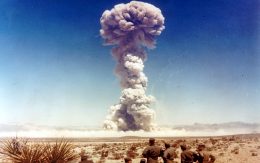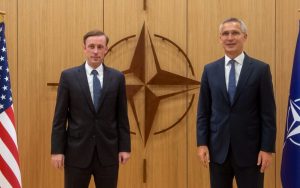The extension of the New START (Strategic Arms Reduction Treaty) has finally come to a happy ending after the expectations of many have fallen short after failing to reach broad consensuses on START II and III.
The New START was signed on April 8, 2010, by Barack Obama and Dimitri Medvedev, aiming to limit the intercontinental ballistic missiles quantity on land, sea and air. Once again, the United States of America and Russia have finally come to an agreement, extending the ratified agreement for five more years. Otherwise, it would have brought back a scenario that has been non-existent for 50 years, where there is no binding agreement on the two largest nuclear arsenals in the world.
The global effort for nuclear disarmament has been led by the largest nuclear arsenal owners in the world. Although others would be willing to collaborate with the objective, for now, the initiative and the main advances must come from decisions taken from the White House and the Kremlin.
Thus, both parties agreed on having no more than 1,550 deployed warheads. Moreover, they can review compliance with the agreement up to 18 times a year and frequently exchange information on movements. As of February 4, the US State Department has registered a total of 21,473 change notifications.
The European Union received the news with euphoria and Josep Borrell Fontelles, the EU High Representative for Foreign Affairs, highlighted in a Tweet that with the signing of the agreement a very important step had been taken for European and international security, considering that this treaty increases predictability and trust between the US and Russia and puts limits on strategic competition. Essentially, as Borrell expressed it, this agreement fulfils the task of guaranteeing verifiable limits for both parties, which especially in times of tension is of vital importance.
Furthermore, in the recently signed agreement, there was an attempt to include China. However, neither Peking nor Moscow agreed on the contents of the Treaty. Instead, Moscow insisted on a bilateral negotiation between the parties concerned and drew attention to the approximately 500 nuclear warheads held by the United Kingdom and France, suggesting that those should also be part of a new agreement.
In essence, we are talking about nine different countries with nuclear capacity. Even though no one has exact figures and some countries refuse to be transparent, this is more or less the current state according to the SIPRI (Stockholm International Peace Research Institute): the US and Russia are on the lead with more than 90% of the total capacity, followed by China, France, the United Kingdom, India, Pakistan, Israel and North Korea. At the beginning of the year, the total number was close to 13,400 warheads, of which 3,750 are deployed and around 2,000 in operational alertness.
As a matter of fact, if we compare the 70,000 warheads from the Cold War that were estimated with today’s modest figure of around 14,000 (even if rounding), it seems that, because of the current amount which is now only one fifth compared to Cold War times, we might assume that the hazard is also only one-fifth of what it was before. However, it is a bit more complex than that, and it is not just about quantity. We must talk also about the weapon’s quality, considering certain advances in the past decades.
When it comes to nuclear weapons, just one single factor can be decisive in a war scene. Let us remember the times of the Cold War, specifically the Cuban Missile Crisis. At the time, with the best technology at hand, it was just about placing the missiles in the right place. The only thing that could prevent a disaster was mutual deterrence.
Nonetheless, today we can simply observe how technology has developed and we could hardly imagine the consequences of what a nuclear war would be like now. And this is where we need to consider the technological advances that occurred parallel to disarmament. Nowadays, we talk about much more efficient weapons (in their capacity of destruction), more selective and precise, reaching a point where the use of mini nuclear weapons on the battlefield is not just an idea, but a reality. The USA and Russia keep a vastly expensive program to replace the old warheads and ballistic systems with ones up to date with current technological standards.
Even though the world’s nuclear armament has been reduced considerably, the ones that remain are more sophisticated and potentially more destructive. 75 years ago, the nuclear weapons dropped over Hiroshima and Nagasaki showed a capacity for destruction never seen before in warfare. Today’s capabilities could vaporize the human race in the blink of an eye, which is why we must insist on pacts that not only work in a discursive way but have some coherence with reality. Therefore, something more reasonable would be to consider the capability of nuclear weapons, and not just the amount thereof.
Sources
Arms Control Association, 2018. Arms Control Association. [Online] Available at: https://www.armscontrol.org/factsheets/USNuclearModernization [Last Access: 15 February 2021].
Arms Control Association, 2021. U.S. Nuclear Modernization Programs. [Online] Available at: https://www.armscontrol.org/factsheets/NewSTART [Last Access: 15 February 2021].
Borrell, J. (2021) 3 February. Available at: https://twitter.com/JosepBorrellF/status/1357032170477527042[Last Access: 15 February 2021].
NTI, 2008. The Costs of U.S. Nuclear Weapons. [Online] Available at: https://www.nti.org/analysis/articles/costs-us-nuclear-weapons/ [Last Access: 15 February 2021].
Reuters Staff, 2020. U.S. prepared to spend Russia, China ‘into oblivion’ to win nuclear race: U.S. envoy. [Online] Available at: https://www.reuters.com/article/uk-usa-armscontrol/u-s-prepared-to-spend-russia-china-into-oblivion-to-win-nuclear-arms-race-u-s-envoy-idUSKBN22X2LS [Last Access: 15 February 2021].
STOCKHOLM INTERNATIONAL PEACE RESEARCH INSTITUTE. World nuclear forces. [Online] Available at: https://www.sipri.org/research/armament-and-disarmament/nuclear-disarmament-arms-control-and-non-proliferation/world-nuclear-forces [Last Access: 15 February 2021].
U.S. DEPARTMENT OF STATE. New START Treaty. [Online] Available at: https://www.state.gov/new-start/ [Last Access: 15 February 2021].








Be First to Comment